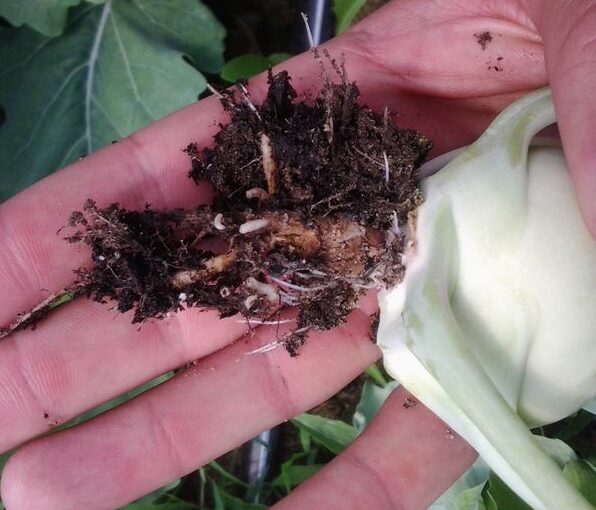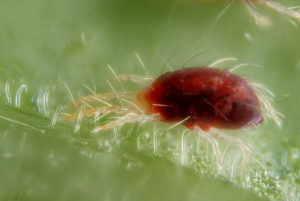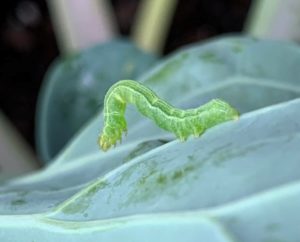Cabbage root maggots can present a problem for members of the brassica family (also known as cruciferous or cole crops), such as broccoli, cauliflower, Brussels sprouts, collards, kohlrabi, radishes, turnips, and cabbage, from which they derive their name.
Damage
The maggot is the larval stage of the cabbage fly. It causes damage by creating tunnels in the roots that may result in yellowing or slightly blue foliage. In addition, you may notice wilted foliage, most notably during the day, as well as stunted growth and an inability to thrive. What’s more, root damage creates opportunities for diseases such as black rot to gain a foothold. Ultimately, the damage can be severe enough to cause the plant to die.
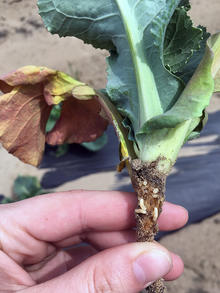
In this article, you will learn how to identify cabbage root maggots, as well as the adult cabbage fly, and discover what you can do to control and prevent this pest from damaging your garden crops.
Life Cycle: How to Identify Cabbage Flies and Root Maggots
Cabbage flies are smaller versions of the more common housefly, being dark gray and measuring approximately 1/5 of an inch in length ( 0.5 cm). The females lay between fifty and 200 white oblong eggs, each measuring about 1/8 of an inch (0.3) cm), in the soil or in the base of the plants at the soil level.
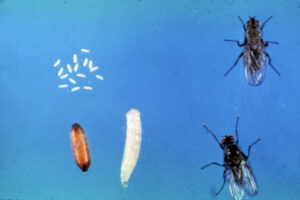
After a few days, white-yellow larvae with tapered heads and blunt posteriors will emerge. The larvae, which measure approximately 1/3 of an inch long ( 0.8 cm), will burrow into the soil to feed on seeds or small roots of young plants. In about one to three weeks, the larvae, or maggots, will pupate in the plants’ roots or nearby in the soil. Several generations are produced each season.
This article contains affiliate links. If you make a purchase using one of these links, I will receive a very small commission at no additional cost to you, and it will help me maintain this website. Rest assured, I only recommend products I actually like!
How to Control Root Maggots
If any of your brassicas exhibit the above described damage, it is time to examine each plant for signs of the maggots.
Search and Destroy. Search for eggs in the top layer of soil near the base of plants, especially if you have seen cabbage flies in and around your plants. Remove and destroy any eggs and continue to search for more each day.
Install Plant Collars. Like preventative measures used for cutworms, one inch tall collars made from the cardboard can be slipped over seedlings or young plants as a barrier to egg-laying female flies.
Install Sticky Traps. Place sticky traps near susceptible crops to catch flies and effectively interrupt reproduction. Keep in mind that beneficial insects may also be caught in the sticky traps.
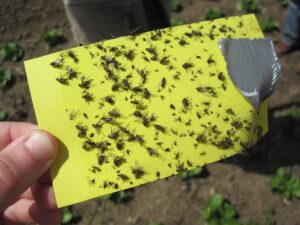
Dig Up and Replant. As a last resort, some recommend carefully digging up plants that display symptoms of root maggots and gently washing their roots in cold water to remove and kill maggots. Afterwards, replant and nurture back to health.
How to Prevent Cabbage Root Maggots
Plant Resistant Varieties. One of the best ways to prevent root maggots is to plant brassica varieties that are resistant to the pest. For example, many red cabbage varieties are more resistant than some of the green cabbage varieties.
Install Row Covers. Row covers like these can be an effective way to prevent cabbage flies from gaining access to plants and laying eggs. Cover the beds or containers as soon as you plant seeds instead of waiting for sprouts to emerge since seeds are susceptible to attack. Keep in mind, however, that you will need to make sure that the edges of the row cover are pressed to the ground to cut off the flies’ access to the crops.
Rotate Crops. Rotate crops each season so that any pupae that have overwintered will not find susceptible crops when they emerge from the soil as adults.
Beneficial Nematodes. Beneficial nematodes like Steinernema feltiae or Sf, can be a productive measure for preventing root maggots. They are easy to buy online.
Plant Later in the Season. Like the strategy for preventing squash vine borers, planting brassicas later in the season delays the availability of susceptible crops for the adult flies to lay eggs in.
Cabbage root maggots pose a real threat to farms and home gardens alike, but with the right measures, they can be effectively controlled and even prevented.
Thank you for reading this article! If you found it interesting or helpful, please consider sharing it with others via email and social media!
